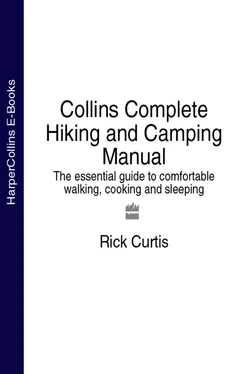Trip Planning
BASIC TRIP PLANNING
Group Size and Ability
Activities
Location and Weather
Expect the Unexpected
Equipment
Food
Costs
Skill Development
TRIP PREPARATION CHECKLIST
Pre-Trip
During the Trip
On Your Return
ROUTE DIFFICULTY
Trip Difficulty Rating
PLANNING A ROUTE
Guidebooks
Travel Logistics
Choosing Campsites
Estimating Travel Times
Time Control Plan
LONG-DISTANCE TRIPS
Resupply Issues

BASIC TRIP PLANNING
Planning a trip requires more than simply deciding where to go and when. Whether it’s a weekend trip with friends, a formal outdoor program, or a major expedition, you need to evaluate your trip across a number of categories and develop a solid plan. One or two people may take on the role of planner, or the process of planning can be spread out among the entire group. After planning and running trips for thousands of people both around the United States and around the world, I can tell you that these are the elements you should keep in mind when planning any trip.
GROUP SIZE AND ABILITY
Whenever you’re planning a trip, you need to determine if the route should fit the group or the group fit the route. The group may have a range of experience levels, physical conditions, and goals, in which case, your goal should be to plan a trip that is appropriate for everyone. Other times, you may have a specific trip you want to do that may be challenging or require special skills. For this kind of trip, you need to select a group that has the right qualifications to participate. Here’s a checklist of questions to ask when planning a group trip:
What kind of group is it? Is it an informal group of friends or a formal group like an outdoor education program? Are the participants friends, students, volunteers, or paying customers? Formal groups may have specific policies and protocols that must be followed.
What are the goals of each group member? Are people required to attend? (This factor can have a significant impact on how committed or not the group is to the wilderness experience.) Does the group have collective goals?
What is the experience level of each member? What is the average experience level?
Are there people in the group with the necessary skills to lead and manage the group, or do you need to find other people to provide leadership? (See “ Outdoor Leadership.”)
How big is the group?
What is the age range of group members?
What is the physical condition of each member? What is the average physical condition of the group?
Do people have particular health issues that could impact their participation?
Determine the level of experience, physical ability, etc., as much as possible before you set out. This will enable you to plan a smoother and more successful trip. More important, it will diminish the potential for dangerous situations. (See “ Safety and Emergency Procedures.”) Keep the group’s parameters in mind as you evaluate the other categories, thinking in terms of both optimal challenge and safety. Be aware that you will often have a great range of experience levels and physical abilities, so plan the trip at a level that will be fun, educational, challenging, and safe for everyone. Think about the high end and the low end of the experience level and physical condition, and err in the direction of the low end. Gathering physical fitness and basic health information will help you determine different abilities and experience levels (for a sample form, see page).
Group Dynamics
How are costs going to be handled—equipment, food, transportation, permits, etc.? If you have to buy gear, who keeps it after the trip? It’s really important to work these things out before the trip, otherwise serious tensions can arise later.
How will leadership be handled during the trip? (See “ Safety and Emergency Procedures,” and “ Outdoor Leadership.”)
ACTIVITIES
When planning the activities for a particular trip, you need to consider the following:
What activity(ies) do you want to do on your trip (backpacking, peak climbing, and/or glacier travel, for example)?
What are the goals for the trip?
What skills will people need? Do they already have the skills, or do they need to learn them?
How do you integrate time for teaching skills with time for traveling?
Once you’ve evaluated the group members’ abilities, you can adapt your goals to an appropriate level. Plan activities that will be both appropriately challenging and safe. Be aware of how mileage, elevation change, and time for teaching and learning skills will affect your route (see “ Estimating Travel Times,”). Start easily and increase the level of difficulty gradually so that everyone can be progressively challenged at appropriate levels, rather than placing someone in a situation that is beyond their abilities.
LOCATION AND WEATHER
Research Your Destination
Investigate the availability of guidebooks and maps.
Contact area rangers or land managers to get more information. Inquire about permits required, safety issues like hunting season, and seasonal hazards like wildfires.
Talk with other people who have been to the area before. If possible, check their trip logs, which may have important information not found in guidebooks.
Trip Planning Questions
How long is the trip? Can the trip be self-supporting in terms of equipment and food, or will you need to resupply? How will you handle the resupply—cache items ahead of time, hike out, or have someone hike in? (See “ Resupply Issues,”.)
How remote is the trip from “civilization” and help in case of an emergency?
What are the trail conditions?
Are there special places you want to see?
Are there places you want to avoid like high-use areas?
Are shelters available on a daily basis, or do you need to bring your own?
Where is parking and trailhead access?
What is the water availability and water quality on a daily basis?
Are there safety issues—hunting season, off-road vehicles, etc.?
Are there any special natural hazards—flash floods in desert canyons, wildfires, etc.? (See “ How Accidents Happen,”.)
What Leave No Trace practices will you need to implement to safeguard the environment? (See “ Leave No Trace Hiking and Camping.”)
Regulations and Permits
Each location can have its own unique set of regulations and requirements. It is important to check these out in detail before you go. Here are some of the possible issues to research:
Are permits needed, and how do you obtain them?
How far in advance do you need to apply for a permit?
Is there a cost for the permit?
Are their any special regulations about rescue? (Some parks, like Denali in Alaska, may require that you pay for your own rescue.)
Are there limitations to group size?
Where is camping allowed and not allowed?
Are there any restricted areas, hazardous zones, protected areas for endangered species, and such?
Are fires allowed? If fires are allowed, will wood be available? Or will you need to bring a stove?
Are there special regulations about Leave No Trace practices such as disposing of human waste?
Weather
How many hours of daylight will there be? Check the Web at sites like the BBC (www.bbc.co.uk) or www.sunrisesunset.com for sunrise and sunset times and average high and low temperatures.
How will the season determine the weather? Are storms or particular weather patterns likely? (See “ Weather and Nature.”)
Читать дальше













